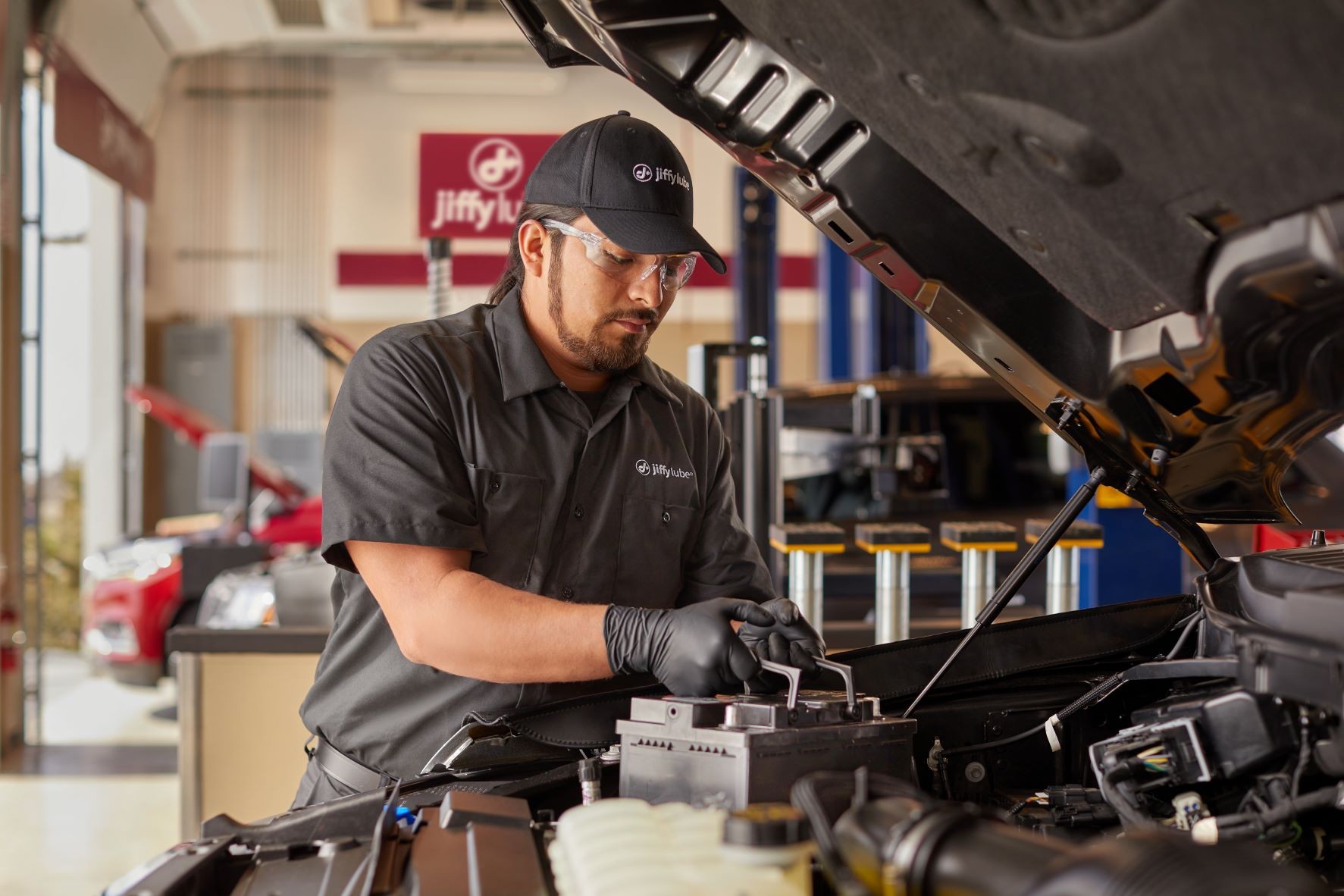Experiencing a car that won’t start due to a dead battery is a frustratingly common scenario for drivers. Picture this: you’re running late, keys in hand, only to be met with silence when you turn the ignition. Before you panic, understand that most drivers will face a dead car battery at some point. The positive takeaway? You can often resolve this issue yourself. Learning How To Charge A Car battery is a valuable skill, empowering you to get back on the road without waiting for roadside assistance. This comprehensive guide will walk you through the process of charging your car battery safely and effectively using a battery charger.
Step 1: Battery Preparation and Safety First
Before you even think about connecting a charger, preparation is key. While many modern vehicles allow for battery charging without removal, some setups require you to carefully lift the battery from its tray. Consult your vehicle’s owner manual to determine if removal is necessary for your car model. If removal is required, ensure the vehicle is turned off and parked on a level surface.
Safety is paramount when dealing with car batteries. Batteries contain sulfuric acid and produce hydrogen gas, both of which are hazardous. Always wear safety glasses and gloves to protect your eyes and skin from acid and potential sparks. Ensure you are working in a well-ventilated area to dissipate any hydrogen gas released during charging. Never smoke or have open flames near a car battery.
Step 2: Power Down Your Vehicle
With the battery prepped and safety measures in place, the next crucial step is to completely power down your vehicle. This means turning off all electronics. Ensure headlights, interior lights, radio, and any accessories plugged into the car’s power outlets are switched off. This minimizes any electrical interference during the charging process and protects your car’s electrical system.
Step 3: Disconnecting Battery Cables – Negative First
Now, it’s time to disconnect the battery cables. It’s critical to disconnect the negative cable first, followed by the positive. This order is important to prevent accidental short circuits.
- Identify the Negative and Positive Terminals: The negative terminal is typically marked with a “-” symbol and often has a black cable. The positive terminal is marked with a “+” symbol and usually has a red cable.
- Loosen and Remove the Negative Cable: Using a wrench of the correct size, carefully loosen the nut or bolt on the negative terminal. Once loose, gently wiggle and pull the cable connector away from the terminal. Secure the negative cable away from the battery terminal to prevent accidental contact.
- Loosen and Remove the Positive Cable: Repeat the process for the positive cable, loosening the connector and removing it from the positive terminal. Keep the positive cable separated from the negative cable to avoid any chance of them touching and creating a short circuit.
 A JiffyLube Technician changes out a customer
A JiffyLube Technician changes out a customer
Step 4: Cleaning Battery Terminals for Optimal Charge
Clean battery terminals are essential for a good electrical connection and efficient charging. Corrosion on the terminals can impede the flow of electricity, hindering the charging process and potentially leading to future battery issues.
- Inspect for Corrosion: Examine the battery terminals for any signs of white, powdery corrosion.
- Prepare Cleaning Solution (Optional DIY): You can use a commercial battery terminal cleaner or create a DIY solution by mixing baking soda and water.
- Clean the Terminals: Apply the cleaning solution to the terminals and use a battery terminal cleaning brush to scrub away any corrosion and dirt. Be thorough in cleaning both the terminals and the inside of the cable connectors.
- Wipe Clean: After cleaning, wipe the terminals and connectors clean with a damp cloth and then dry them thoroughly. This ensures no residue is left behind.
Step 5: Connecting the Car Battery Charger – Positive Then Negative
With clean terminals and disconnected cables, you’re ready to connect your car battery charger.
Important Note: Always consult your car battery charger’s instruction manual. Charger models can vary, and the manufacturer’s instructions should always take precedence.
- Ensure Charger is Off: Before connecting any cables, make sure your car battery charger is powered off and unplugged from the power source.
- Connect Positive Clamp First: Attach the red (positive) clamp of the battery charger to the positive (+) terminal of your car battery. Ensure a firm and secure connection.
- Connect Negative Clamp Second: Connect the black (negative) clamp of the charger to the negative (-) terminal of the battery. Again, ensure a secure connection.
- Set Charger Settings: Most chargers have settings for voltage and amperage. For a standard 12-volt car battery, ensure the charger is set to 12 volts. Start with a low amperage setting (e.g., 2-4 amps) for a slow, gentle charge, which is generally better for battery health. Some chargers offer a “trickle charge” mode, ideal for deeply discharged batteries. For faster charging, you can increase the amperage, but always monitor the battery temperature during faster charges.
- Set Charging Time (If Applicable): Some chargers have timers. The charging time depends on the battery’s state of discharge and the charger’s amperage. Refer to your charger’s manual or your vehicle’s owner’s manual for guidance on charging times. As a general rule, a slow charge over several hours is preferable to a rapid charge.
Step 6: Disconnecting the Charger After Charging – Positive First
Once the charging process is complete, it’s crucial to disconnect the charger in the correct order and safely.
- Power Off the Charger: Turn off the car battery charger and unplug it from the power outlet before disconnecting any cables.
- Disconnect Positive Clamp First: Remove the red (positive) clamp from the positive terminal of the battery.
- Disconnect Negative Clamp Second: Remove the black (negative) clamp from the negative terminal.
- Reinstall Battery (If Removed): If you removed the battery in Step 1, carefully place it back into its tray and secure it with the hold-down clamp(s).
- Reconnect Battery Cables – Positive Then Negative: Reconnect the positive cable to the positive terminal first, ensuring a secure connection. Then, reconnect the negative cable to the negative terminal, also making sure it’s firmly attached.
- Dispose of Cleaning Materials Safely: If you used a cleaning solution, dispose of any cloths or brushes according to the product instructions or local regulations.
Step 7: Post-Charge Battery Check and Maintenance
Knowing how to charge a car battery is a great first step, but it’s important to remember that a dead battery can sometimes indicate underlying issues with your car’s charging system or the battery itself.
- Start Your Car: Attempt to start your car. If it starts successfully, monitor its performance.
- Battery Check at Jiffy Lube® (Recommended): While your car may be running, it’s wise to have your battery professionally checked. Visit a trusted service center like Jiffy Lube for a comprehensive battery test. Technicians can assess your battery’s health, check its voltage and amperage, and evaluate the overall condition of your charging system, including the alternator and starter. Regular battery checks are a crucial part of preventative car maintenance, helping to avoid unexpected breakdowns and ensuring your vehicle remains reliable.
Just because your car is running again after a charge doesn’t guarantee your battery is in optimal condition. A professional battery check can identify potential problems before they lead to another dead battery and leave you stranded. Make battery checks a routine part of your car care, ideally with every oil change, to ensure peace of mind and reliable vehicle operation.
Make a battery check part of your regular car maintenance regimen. Each time you come in for an oil change, why not ask the tech to inspect the battery, too?
Read More About Car Battery Care
Now that you’ve learned how to charge a car battery, expand your knowledge with further resources on car battery maintenance and care. Explore articles and guides on extending battery life, understanding battery types, and recognizing the signs of a failing battery. Proactive car battery care can save you from future headaches and keep your vehicle running smoothly.
NOTE: Not all services are offered at all Jiffy Lube service centers. Please call ahead or check jiffylube.com to ensure the service is available.
